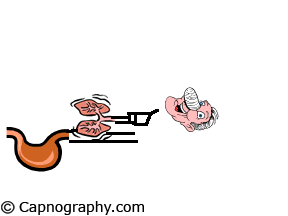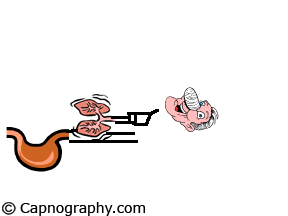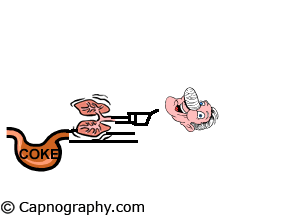Clinical Aspects
Accidental esophageal intubation
Tracheal intubation

Esophageal intubation

Capnograms during esophageal intubation
| Flat line – No CO2 | Few Blips of CO2 from the upper airway and esophagus |
 |
 |
Esophageal intubation following a mask ventilation. Mask ventilation pushes alveolar gas into the esophagus and stomach

Ingestion of carbonated beverages prior to anesthesia


When used with the standard technique of listening to breath sounds, C02 monitoring is probably the best way to detect esophageal intubation. Although C02 may be present in the stomach it is rapidly flushed out during ventilation of the stomach and the PETCO2 reading would decrease, resulting in a flat capnogram.1,2 Recently, PETCO2 detectors, which change color on exposure to 4% C02, have been used successfully to confirm tracheal intubation.3 These detectors can be used where CO2 monitors are not available.3 It should be noted that in the presence of carbonated beverages in the stomach a PETCO2 as high as 38 mmHg can be observed with esophageal ventilation and it may take at least six breaths for PETCO2 to decrease to zero. However, the C02 waveforms produced as a result are abnormal in shape and, therefore, could be detected earlier by capnography than capnometry.4
Continuous recordings of C02 at the proximal end of the nasal tracheal tube facilitate guiding of the tube towards the larynx during blind nasal intubation in the spontaneously breathing patient. As the tube is moved away from the larynx, the end-tidal recordings decrease.5 Carbon dioxide recordings can be replaced by audio signals that are proportional to C02 concentration (audio capnometry). This has the advantage that one does not have the distraction of looking at the capnometer during the procedure.6
Proper positioning of double lumen-tubes
References
1. Birmingham PK, Cheney FW, Ward RJ. Esophageal intubation: a review of detection techniques. Anesth Analg 1986;65:886-91.
2. Linlo K, Paloheimo M, Tammisto T. Capnography for detection of accidental oesophageal intubatio. Acta Anaesthesiol Sand 1983;27:199-202.
3. . ‘O’ Flaherty D, Adams AP. The end-tidal carbon dioxide detector. Assessment of new method to distinguish oesophageal from tracheal intubation. Anaesthesia 1990;45:653-5.
4. Sum Pink ST, Mehta MP, Symreng T. Reliability of capnography in identifying esophageal intubation with carbonated beverage or anatacid in the stomach. Anesth Analg 1991;73:333-7.
5. Linlo K, Paloheimo M. Capnography facilitates blind nasotracheal intubation. Acta Anaesthesiol Belg 1983;34:117-22.
6. Omoigui S, Glass P, Martel DIJ, et al. Blind nasal intubation with audio-capnometry. Anesth Analg 1991;72:392-3.
7. Shafieha MJ, Sit J, Kartha R et al. End-tidal CO2 analyzers in proper positioning of the double-lumen tubes. Anesthesiology 1986;64:844-5.
8. Shankar KB, Moseley H, Kumar AY. Dual end-tidal CO2 monitoring and double-lumen tubes. Can J Anaesth 1992;39:1000-3.
9. Bhavani-Shankar K, Russell R, Aklog LMushlin P. Dual capnography facilitates detection of a critical perfusion defect in an individual lung. Anesthesiology 1999; 90 (1): 302-304.

 Twitter
Twitter Youtube
Youtube









